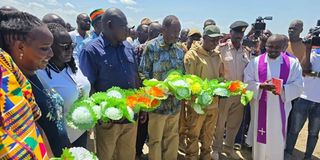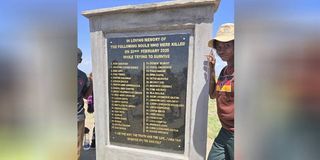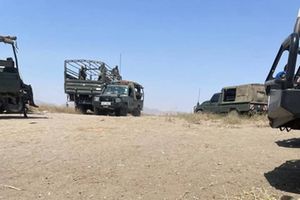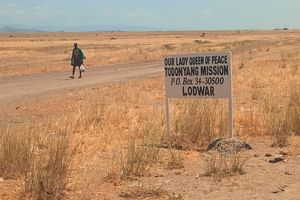
Turkana Governor Jeremiah Lomorukai unveiling a memorial monument at Todonyang mass grave site with 40 names of people killed during the attack by Dassenech militia from Ethiopia.
A monument bearing the names of 40 Kenyans believed to have been killed by militia from Ethiopia at Todonyang in February has been unveiled by Turkana Governor Jeremiah Lomorukai, six weeks after the attack.
The monument has the names of 40 missing Kenyans believed to be victims of the February 22 killings by suspected Dassenech militiamen along the shores of Lake Turkana.
Since the attack, the victims, who include pastoralists, fishermen and traders at Lotiira and Lopeimukat villages bordering Ethiopia, have been missing.
However, only three bodies have since been recovered following an operation by Kenyan security services led by Interior Cabinet Secretary Kipchumba Murkomen.
The monument bearing the date April 3 reads: "In loving memory of the following souls who were killed on 22nd February 2025 while trying to survive."
Visiting the village for the first time since the incident to condole with the families of the affected people, Governor Lomorukai unveiled the memorial monument at a graveyard established by residents and Our Lady Queen of Peace Todonyang Mission of the Catholic Diocese of Lodwar.
This is a cemetery where victims of past militia attacks are buried. It is in this mass grave that 42 Kenyans who were massacred on May 2, 2011, are interred.
"I unveiled a memorial monument for the innocent fishermen who lost their lives in the tragic attack. Their memory will forever remind us of the need for peace and security along our borders," Mr Lomorukai said.
"We will stand with our people and ensure Todonyang rises stronger from this tragedy," he said.
The county boss was accompanied by political leaders from Turkana North Constituency, including former Petroleum Cabinet Secretary John Munyes, newly elected County Speaker Charles Lokioto and senior county government officials.
But Mr Murkomen disputed the characterisation that the missing persons are dead, arguing that without the recovery of bodies, there is no evidence of their deaths.
“Our security forces responded, and in two days, I was there. We engaged our Ethiopian counterparts in a diplomatic mission and unfortunately, we only recovered three bodies,” Mr Murkomen said on Monday night, responding to reports of the unveiling of the memorial by the governor listing the 40 victims.
“It’s a dicey situation, and we condole with the family. The operation is open. That place has wildlife, and assuming most people lost their lives, we can’t legally say these are the people who died without evidence. We cannot authoritatively say these are the numbers as the incident happened in the lake,” the CS said.
A search and rescue effort for the missing Kenyans began on February 26 on Ethiopian grounds, more than 96 hours after the cross-border attack had happened at Todonyang along the Kenya-Ethiopia border.

Turkana leaders at a memorial monument for 40 people who were killed during the attack by Dassenech militia from Ethiopia
At the time, the Interior CS directed the formation of a team led by Rift Valley Regional Commissioner Dr Abdi Hassan to negotiate with Ethiopian authorities to facilitate access to the Ethiopian side.
"We will work with the national government to find permanent solutions to perennial attacks and cement peaceful coexistence with our neighbours to promote cross-border trade. To guarantee security, we are pushing for the establishment of Lakezone sub-county, which will significantly strengthen security presence in this region," the governor said.
Turkana North Deputy County Commissioner George Orina said a joint team of security personnel and Red Cross Society volunteers from both Kenya and Ethiopia, with support from Kenya Coast Guard and Kenya Maritime Authority officials, has been concentrating on retrieving boats and nets.
"We were also still waiting for the Ethiopian authorities to hand over seven boats belonging to Kenyan fishermen that they recovered. Fishing activities have resumed on the Kenyan side of the lake," Mr Orina said.
Locals appealed to the government to beef up security in the region.

A monument in Todonyang village for those killed in February by militia from the Dassenech community of Ethiopia, with 40 names that was unveiled by Turkana Governor Jeremiah Lomorukai on March 3, 2025.
"We are mainly being protected by national police reservists who are few and have guns without ammunition. Border patrol unit that is stationed at the border is also not well equipped and lacks vehicles that can facilitate their operations on poorly maintained roads," said Mr Paul Emase, a Todonyang resident.
Turkana North MP Paul Nabuin wondered why authorities would require permission from neighbouring countries to access parts of Kenya to rescue citizens or recover bodies.
"The border between Kenya and Ethiopia is demarcated, and there is no dispute about the border. We are in this situation because of fishing activities and the location where fish is concentrated. The Ethiopian militia moved into Kenyan territory and restricted entry of the Kenyans, resulting in an on-and-off conflict, including the recent Todonyang killings," he explained.









